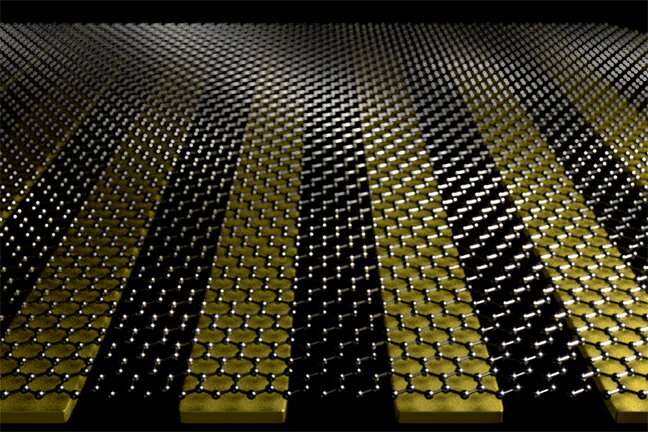New graphene-based device is first step toward ultrasensitive biosensors

Researchers in the University of Minnesota College of Science and Engineering have developed a unique new device using the wonder material graphene that provides the first step toward ultrasensitive biosensors to detect diseases at the molecular level with near perfect efficiency.
Ultrasensitive biosensors for probing protein structures could greatly improve the depth of diagnosis for a wide variety of diseases extending to both humans and animals. These include Alzheimer's disease, Chronic Wasting Disease, and mad cow disease—disorders related to protein misfolding. Such biosensors could also lead to improved technologies for developing new pharmaceutical compounds.
The research is published in Nature Nanotechnology, a peer-reviewed scientific journal published by Nature Publishing Group.
"In order to detect and treat many diseases we need to detect protein molecules at very small amounts and understand their structure," said Sang-Hyun Oh, University of Minnesota electrical and computer engineering professor and lead researcher on the study. "Currently, there are many technical challenges with that process. We hope that our device using graphene and a unique manufacturing process will provide the fundamental research that can help overcome those challenges."
Graphene, a material made of a single layer of carbon atoms, was discovered more than a decade ago. It has enthralled researchers with its range of amazing properties that have found uses in many new applications, including creating better sensors for detecting diseases.
Significant attempts have been made to improve biosensors using graphene, but the challenge exists with its remarkable single atom thickness. This means it does not interact efficiently with light when shined through it. Light absorption and conversion to local electric fields is essential for detecting small amounts of molecules when diagnosing diseases. Previous research utilizing similar graphene nanostructures has only demonstrated a light absorption rate of less than 10 percent.
In this new study, University of Minnesota researchers combined graphene with nano-sized metal ribbons of gold. Using sticky tape and a high-tech nanofabrication technique developed at the University of Minnesota, called "template stripping," researchers were able to create an ultra-flat base layer surface for the graphene.
They then used the energy of light to generate a sloshing motion of electrons in the graphene, called plasmons, which can be thought to be like ripples or waves spreading through a "sea" of electrons. Similarly, these waves can build in intensity to giant "tidal waves" of local electric fields based on the researchers' clever design.
By shining light on the single-atom-thick graphene layer device, they were able to create a plasmon wave with unprecedented efficiency at a near-perfect 94 percent light absorption into "tidal waves" of electric field. When they inserted protein molecules between the graphene and metal ribbons, they were able to harness enough energy to view single layers of protein molecules.
"Our computer simulations showed that this novel approach would work, but we were still a little surprised when we achieved the 94 percent light absorption in real devices," said Oh, who holds the Sanford P. Bordeau Chair in Electrical Engineering at the University of Minnesota. "Realizing an ideal from a computer simulation has so many challenges. Everything has to be so high quality and atomically flat. The fact that we could obtain such good agreement between theory and experiment was quite surprising and exciting."
More information: In-Ho Lee et al, Graphene acoustic plasmon resonator for ultrasensitive infrared spectroscopy, Nature Nanotechnology (2019). DOI: 10.1038/s41565-019-0363-8
Journal information: Nature Nanotechnology
Provided by University of Minnesota





















